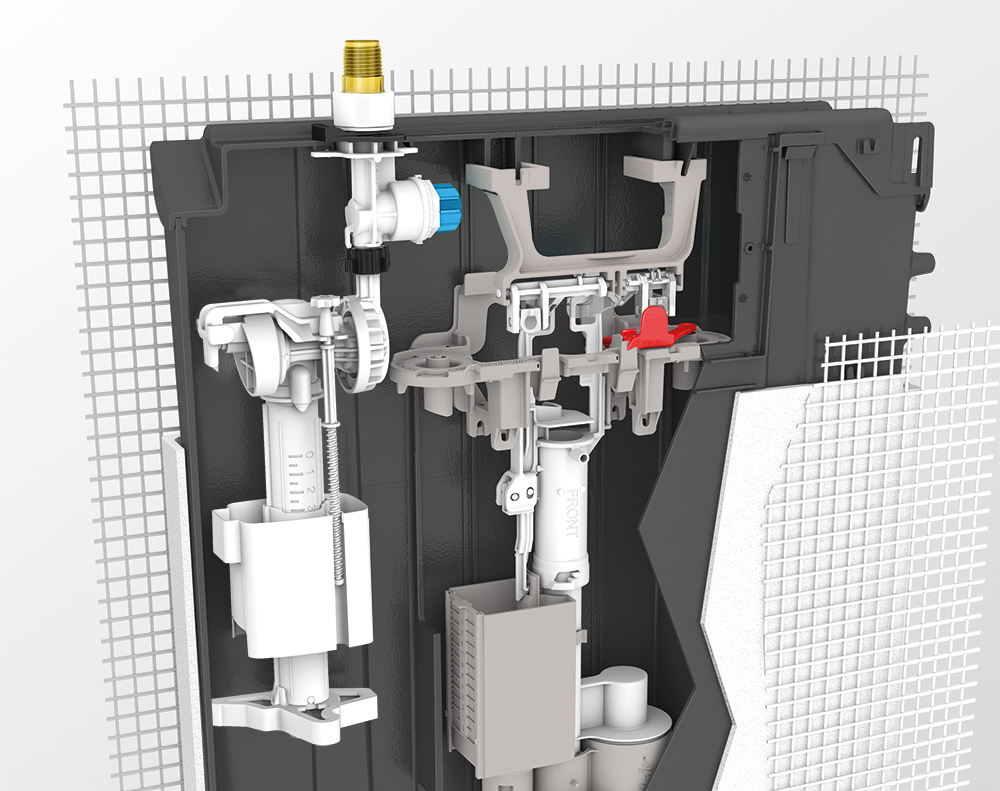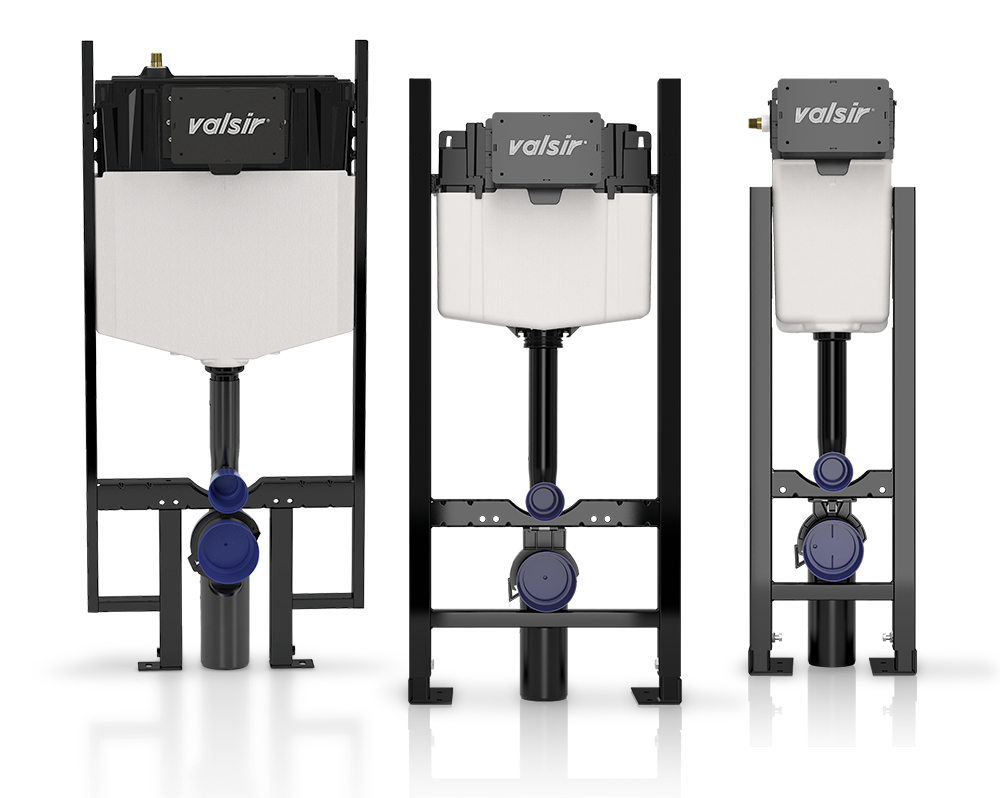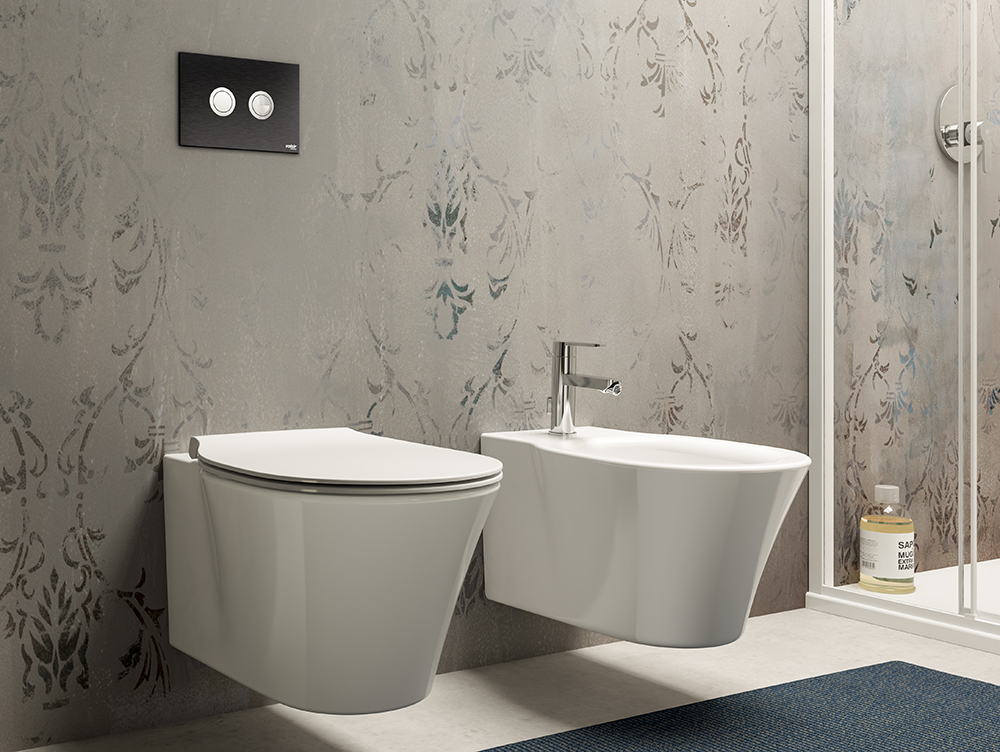The in-wall cistern is an essential component of the bathroom plumbing system, designed to be installed inside the wall and remain invisible from the outside. Its purpose is to collect and release the water needed to flush the toilet, ensuring hygiene and efficiency.
Unlike exposed cisterns, which are visible and mounted on the wall, in-wall cisterns offer a significant aesthetic and functional advantage. Their minimal space requirements, the possibility of installing wall-hung sanitary fixtures and their quiet operation make in-wall toilet cisterns the ideal solution for modern bathrooms.
The evolution of in-wall cisterns over time
Over the years, in-wall cisterns have undergone significant technological evolution. The materials used have evolved towards advanced technical solutions such as sound-absorbing polymers, which improve quietness during the filling phase.
At the same time, the focus on water saving has led to the adoption of adjustable dual flush systems (6/3, 4.5/3, 4/2 litres), contributing to environmental sustainability. Furthermore, integration with the aesthetics of the bathroom has become essential: today's in-wall cisterns adapt perfectly to any setting.
How an in-wall cistern is made
An in-wall cistern consists of a main structure (which can be wall-mounted or free-standing), a plastic container and a number of internal components: the shut-off valve, the float valve and the flush valve.

The shut-off valve (connected to the water supply) allows the water flow to be interrupted if necessary for maintenance. The float valve regulates the water level according to the settings and, consequently, the amount of water released with each flush.
The waste valve allows the water to be released into the toilet bowl. All these components are designed to ensure efficiency, quiet operation and ease of maintenance when necessary.
Valsir cisterns
Valsir offers a complete range of in-wall cisterns that stand out for their compactness, quietness and installation versatility:
- Tropea S is the slimmest in the range, with a thickness of only 90 mm. Made of a soundproofing plastic compound, it guarantees large water savings, thanks to adjustments down to only 4/2 litres. ISO EN 3822 and EPD certified.
- Winner S is the lowest cistern on the market (starting from 800 mm in height), perfect for installation in small spaces or under windows. Thanks to its versatility, it can be used with different types of walls and toilets. This model is also certified for quietness and water efficiency, EN 3822 and EPD.
- Cubik S is the compact solution par excellence. Also designed to reduce acoustic vibrations and facilitate installation, it is compatible with all types of flush actuators.

Sound insulation and sound-absorbing materials
In the home, acoustic comfort is essential. Modern in-wall cisterns use materials designed to minimise the noise produced during filling.
Our toilet cisterns use a plastic compound that absorbs vibrations and reduces perceived noise. The internal components, such as the float valve and flush valve, are certified according to ISO EN 3822 and CSTB NF standards, guaranteeing silent performance even at high pressures (up to 5 bar).
Sustainability and water saving
The latest generation of in-wall cisterns are designed to optimise the use of an important resource such as water. Thanks to dual flush systems, users can choose the amount of water to use according to their needs. The most advanced cisterns allow efficient and precise adjustments (6/3, 4.5/3, 4/2 litres), reducing water waste.
All our cisterns comply with EPD (Environmental Product Declaration) standards and can contribute to obtaining WELL and LEED certifications, which are essential in sustainable building projects.
The in-wall cistern is standard in any modern home, as it offers many advantages, starting with aesthetics (since it is completely hidden and allows for easier management of space and bathroom furnishings): it is silent during the filling phase, it saves considerable amounts of water thanks to the dual flush system and, compared to traditional models used in the past, it requires less water to clean the toilet, helping to save a very important natural resource.
Adaptability and installation flexibility
One of the great strengths of our in-wall cisterns is their versatility. They can be installed on masonry walls, plasterboard or mixed structures thanks to specific frames for each type of installation: Fixsystem, Block or Block self-supporting.
All models are supplied pre-assembled to reduce installation time on site and are equipped with accessories designed to facilitate every stage of installation, such as mounting templates and adjustable fittings. They are therefore ideal for optimising operations in both new buildings and all types of renovation work.
Compatibility with floor-mounted and wall-hung toilets
The in-wall cisterns are perfectly suited to both floor-mounted and wall-hung toilets. In particular, the combination with wall-hung sanitary fixtures allows for greater hygiene and easier cleaning of the floor.

All our in-wall cisterns are designed to guarantee a static load of 400 kg, as required by EN 997. The horizontal and vertical adjustments of the bends allow for any misalignments to be compensated for and ensure maximum precision during installation.
Maintenance of the in-wall cistern
Contrary to what one might think, the maintenance of an in-wall cistern is simple and accessible to everyone, even if you are not a plumber. All the main components can be inspected by removing the front plate.
Our cisterns are designed to allow maintenance without tools, thanks to intuitive guides and simple, essential components. The valves and floats are made of limescale-resistant materials, ensuring a long life for the cistern and low running costs over time.
The in-wall cistern in designer bathrooms
In contemporary bathroom design, the in-wall cistern is a valuable ally. Its invisible presence allows you to maintain a clean and essential style, in harmony with high-quality materials and furnishings. Thanks to its compatibility with different types of flush mechanisms, you can create completely customised environments without sacrificing functionality.
 Italiano
Italiano
 English
English
 Deutsch
Deutsch
 Français
Français
 Español
Español
 Greek
Greek